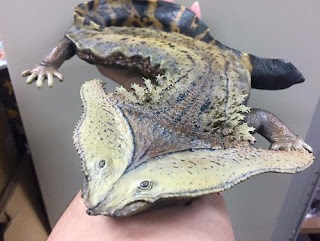DIPLOCAULUS
THE DIPLOCAULUS
THE DIPLOCAULUS IS A GENDER COMING FROM LEPONDILOS THAT LIVED ON THE PERIOD PERMICO
270 MILIONS OF YEARS AGO
THE FIRST DISCOVERED WAS IN TEXAS BY EDWARD COPE IN THE WAR CALLED THE WAR OF THE BONES
THE ADULTS CAN HAVE A METER OF LONG APROXIMATELY THEY LIVED IN THE WATER HIS NIKNAME WAS ARROW HEAD
SOME SCIENTIFICS THINK THAT THIS DINOSAUR EVOLUCIONED TO A SALAMANDER BUT THEY ARE NOT SURE
THE DIPLOCAULUS IS A GENDER COMING FROM LEPONDILOS THAT LIVED ON THE PERIOD PERMICO
270 MILIONS OF YEARS AGO
THE FIRST DISCOVERED WAS IN TEXAS BY EDWARD COPE IN THE WAR CALLED THE WAR OF THE BONES
THE ADULTS CAN HAVE A METER OF LONG APROXIMATELY THEY LIVED IN THE WATER HIS NIKNAME WAS ARROW HEAD
SOME SCIENTIFICS THINK THAT THIS DINOSAUR EVOLUCIONED TO A SALAMANDER BUT THEY ARE NOT SURE
The Diplocaulus is an extinct genus of amphibians that belongs to the group of lepospóndilos, some primitive tetrapoThe Diplocaulus is an extinct genus of amphibians that belongs to the group of lepospóndilos, some primitive tetrapods that inhabited the earth for more than 70 million years.ds that inhabited the earth for more than 70 million years.
In no case should we confuse the Diplocaulus with a dinosaur, because it even came to live before these. And is that this ancestral amphibian completely disappeared from our planet when the dinosaurs began to inhabit it.
To be concrete, they lived during what is now known as Paleozoic Era. This era is what happened just before the appearance of the dinosaurs. The Diplocaulus, within the Paleozoic Era, inhabited concretely in the subdivision known as Permian.
The characteristic feature of the Diplocaulus were its spectacular heads as they had a somewhat impressive appearance, with a very large dimension and totally disproportionate to the rest of the body.
The Diplocaulus is an extinct genus of amphibians that belongs to the group of lepospóndilos, some primitive tetrapods that inhabited the earth for more than 70 million years.
In no case should we confuse the Diplocaulus with a dinosaur, because it even came to live before these. And is that this ancestral amphibian completely disappeared from our planet when the dinosaurs began to inhabit it.
To be concrete, they lived during what is now known as Paleozoic Era. This era is what happened just before the appearance of the dinosaurs. The Diplocaulus, within the Paleozoic Era, inhabited concretely in the subdivision known as Permian.
The characteristic feature of the Diplocaulus were its spectacular heads as they had a somewhat impressive appearance, with a very large dimension and totally disproportionate to the rest of the body.
The Diplocaulus is an extinct genus of amphibians that belongs to the group of lepospóndilos, some primitive tetrapods that inhabited the earth for more than 70 million years.
In no case shoThe Diplocaulus is an extinct genus of amphibians that belongs to the group of lepospóndilos, some primitive tetrapods that inhabited the earth for more than 70 million years.
In no case should we confuse the Diplocaulus with a dinosaur, because it even came to live before these. And is that this ancestral amphibian completely disappeared from our planet when the dinosaurs began to inhabit it.
To be concrete, they lived during what is now known as Paleozoic Era. This era is what happened just before the appearance of the dinosaurs. The Diplocaulus, within the Paleozoic Era, inhabited concretely in the subdivision known as Permian.
The characteristic feature of the Diplocaulus were its spectacular heads as they had a somewhat impressive appearance, with a very large dimension and totally disproportionate to the rest of the body.
uld we confuse the Diplocaulus with a dinosaur, because it even came to live before these. And is that this ancestral amphibian completely disappeared from our planet when the dinosaurs began to inhabit it. To be concrete, they lived during what is now known as Paleozoic Era. This era is what happened just before the appearance of the dinosaurs. The Diplocaulus, within the Paleozoic Era, inhabited concretely in the subdivision known as Permian. The characteristic feature of the Diplocaulus were its spectacular heads as they had a somewhat impressive appeara2



Comentarios
Publicar un comentario